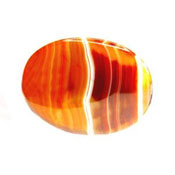Carnelian
(kahr-neel-yuh n)
HISTORY and LORE
- Treasured by early civilizations from Egypt to China. During Greek and Roman times, often used for signet rings and the engraved gems known as intaglios.
- Traditionally believed to drive away evil, attract good, protect from envy, and give its wearer courage.
- Probably named for the fruit of the cornel or cornelian cherry tree.
- Birthstone for Virgo.
VALUE FACTORS
- Color: Orange to yellow-orange and red-orange, often somewhat brownish.
- Clarity: Usually translucent
- Cut: : Mostly cut into cabochons, but also into carvings, tablets, and beads in a wide variety of shapes.
- Size/Weight: All sizes are available. Occurs in pieces big enough for large carvings and other ornamental purposes. (Normally not priced or sold by carat weight.)
TREATMENT
- Commonly produced by heat treating yellow or brown chalcedony. The process duplicates heating that can occur naturally in the Earth, and has been used for thousands of years. Heat-treated carnelian was found in the tomb of Egypt’s Pharaoh Tutankhamen (who died around 1325 BC). The treatment’s effects are normally permanent, and it creates no special care requirements.
GEMOLOGY
- A variety of the mineral species chalcedony. Other chalcedony varieties include agate, bloodstone, onyx, and sardonyx.
- Composed mostly of silicon and oxygen; chemical formula SiO2. (Essentially the same as quartz, but made up of individual crystals so tiny they can’t be seen without high magnification.) Color caused by iron oxide.
CARE
Carnelian generally has good wearability.
- Hardness: Moderate scratch resistance. Rates 6.5 to 7 on the Mohs Hardness Scale.
- Toughness: Good resistance to chipping and breaking.
- Stability: No routine concerns for gem owners
- Cleaning: Liquid cleaner, or detergent and water. Ultrasonic is usually safe.
